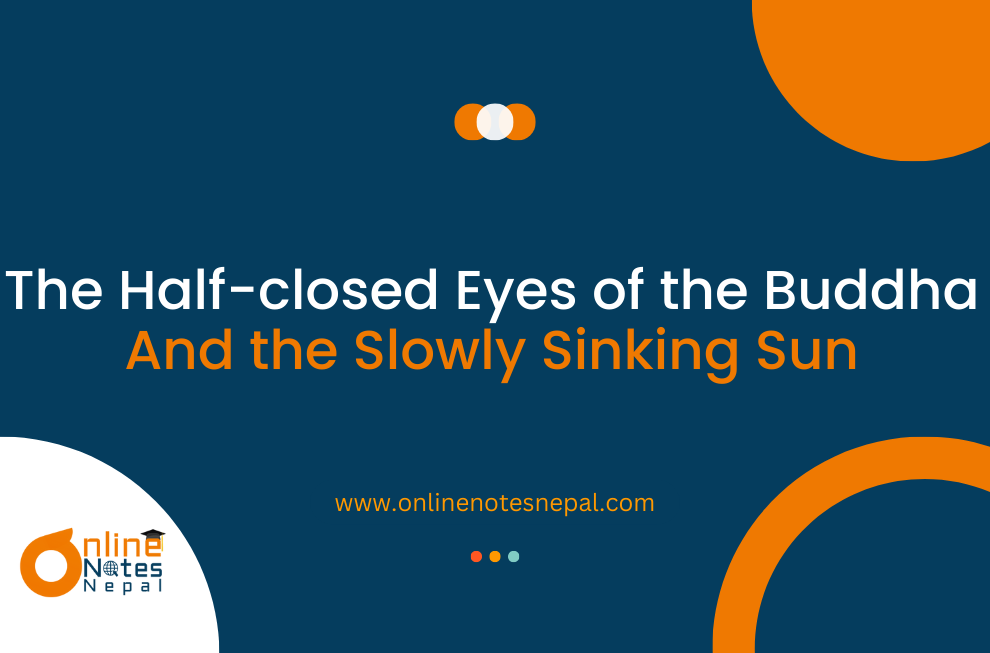Published by: Prastu Regmi
Published date: 10 Sep 2024

"The Half-Closed Eyes of the Buddha and the Slowly Sinking Sun" by Shankar Lamichhane is a straightforward story conveyed through a conversation between two characters: a visitor and a guide. It was included in the anthology Himalayan Voice: An Introduction to Modern Nepali Literature, published in 1991. The story takes place in and around Kathmandu, Nepal's capital city.
In the story, both individuals serve as narrators. The first is a Nepalese guide, whereas the second is a foreign tourist. However, the Western tourist claims to be an expert, stating, "I could take you along your ancient ways." "You are my tour guide for today, but I believe I can also help guide you," the Nepali guide responds, implying that he is more knowledgeable about the subject at hand.
The novel begins with a lovely atmospheric description of the Kathmandu Valley, full of visual beauty and the many colors of homes, blue hills, and so on. The guest then reflects on the East's many contributions, including the Purans, ancient tools, ivory jewelry, palm leaf texts, and copperplate inscriptions. The tourist then tells stories about Manjushri and how he stroked his sword at Chobhar, allowing people to settle in Kathmandu Valley later on, as well as "the samyak gaze" of the shaven-headed monks and nuns who were receiving alms and spreading Buddhist preaching near the Kasthamandap, which represented purity.
They then talk about their love of wooden figurines, Nepalese folk music, different civilizations (Aryans, non-Aryans, Hindus, Buddhists), and drinking wine. The traveler thanks the guide for supplying him with Nepali and Newari cuisine. Following that, they look at the lives and histories of Princess Bhrikuti and King Amshuvarma, as well as how the King developed his connections with neighboring countries, as depicted in the film and told by an older man to his grandson. The tourist is pleased by the warm smiles he receives wherever he goes, likening it to the farmer's son returning home from hard labor and assuming himself and the people's hospitable behavior. They have one more drink to honor the Nepalese people's lovely smiles.
Then they investigate different forms of eyes, including the eyes in the windows, the eyes on the door panels, the eyes on the stupas, the eyes of the people, the eyes of the Himalayas, and the Lord Buddha's half-closed eyes, referring to the country as a land of eyes. These eyes reflect a new culture, a wide range of religions, civilization, deep memories, and a lengthy journey.
The guide describes the Adinath temple, a Shiva shrine surrounded by numerous other portraits of Buddha--a living example of Nepalese tolerance and coexistence--but then takes the visitor to a residence where he discovers the pulse of reality. It's a farmer's household with a paralyzed kid (polio-affected child) whose entire body is worthless, and he can't speak, move his hands, chew his food, or even spit, except his eyes, which are directly opposite his sister. When the guide introduces the visitor as a doctor, the parents are overjoyed. Their eyes reveal a depth of faith, connection, generosity, and gratitude.
Finally, the guide explains that these are the mountains' eyes, and their lashes are rows of fields where rice ripens in the rain and wheat ripens in the winter. They are as beautiful as the reflection of the setting sun in the Buddha's eyes.
1. How is the author able to integrate two fragments of the narration into a unified whole?
ans: The author of the story "The Half-Closed Eyes of the Buddha and the Slowly Sinking Sun" aims to combine two pieces of narrative into a coherent whole by connecting them with instances of eyes and associating them with two distinct universes. The author describes both communal events and people's jobs. On the other hand, he associates it with the world of farmers, where people are ignorant of the outside world and suffer from a variety of traditional beliefs and maladies.
Thus, by connecting two distinct worlds or concepts of the East and West, he delivers the message that one should see things through their deeper eyes and see the full meaning of the situation. He associates the guide's voyage with the tourist and viewing the item on the one hand, and the guide describes the meaning of the places and activities on the other, using examples of eyes and his stream-of-consciousness narrative tactics.
2. Which narrative technique is used by the author to tell the story? How is this story different from other stories you have read?
ans: The author used the 'stream of consciousness technique' in this piece. This narrative differs from others I've read because it contains both positive and negative components. Unlike many other stories, in which the author only writes about the story's events from one perspective, this story is told through the monologues of two characters: a Kathmandu Valley tourist guide and a foreign tourist. Many of the conventional stories I've read use stream-of-awareness tactics, in which the narrator depicts the action and happenings through imaginary characters or other means.